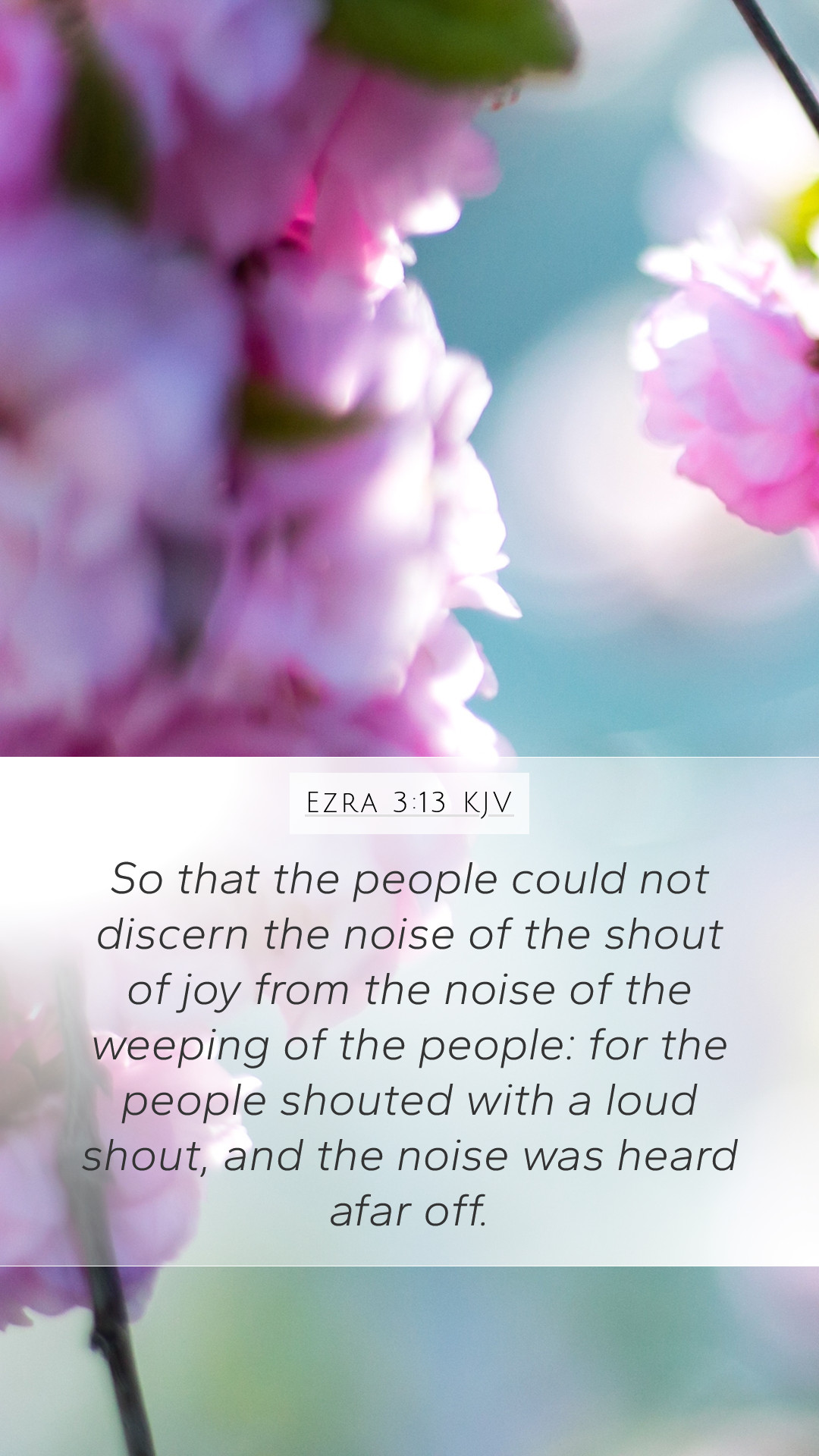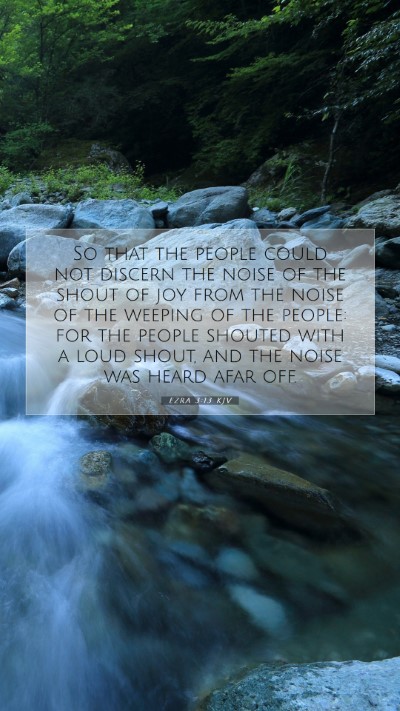Old Testament
Genesis Exodus Leviticus Numbers Deuteronomy Joshua Judges Ruth 1 Samuel 2 Samuel 1 Kings 2 Kings 1 Chronicles 2 Chronicles Ezra Nehemiah Esther Job Psalms Proverbs Ecclesiastes Song of Solomon Isaiah Jeremiah Lamentations Ezekiel Daniel Hosea Joel Amos Obadiah Jonah Micah Nahum Habakkuk Zephaniah Haggai Zechariah MalachiEzra 3:13 Meaning
What is the meaning of Ezra 3:13?
So that the people could not discern the noise of the shout of joy from the noise of the weeping of the people: for the people shouted with a loud shout, and the noise was heard afar off.
Ezra 3:13 Bible Verse Meaning
Understanding Ezra 3:13
Ezra 3:13 states:
"So that the people could not discern the noise of the shout of joy from the noise of the weeping of the people: for the people shouted with a loud shout, and the noise was heard afar off."
Meaning of the Verse
This verse captures a poignant moment during the rebuilding of the temple in Jerusalem following the Babylonian exile. The response of the people -- for some, it was a shout of joy for the new beginnings, while for others, it was a cry of sorrow for the previous temple's glory and the reality of their diminished circumstances.
The confusion of sounds signifies various emotional responses to a significant event in the life of the community. It reflects how the human experience can be multifaceted; joy and sorrow can coexist, showing the complexity of historical and communal shifts.
Bible Verse Commentary
- Matthew Henry: Henry reflects on the mixed emotions of the people, emphasizing that the joy of some was met with the sorrow of others, highlighting the pain of loss that coexists with the joy of restoration.
- Albert Barnes: Barnes notes that the overwhelming sound illustrates the deep emotional investment of the community in the temple's reconstruction, suggesting that such events bring forth various reactions from different individuals.
- Adam Clarke: Clarke comments on how the festival of the restoration produced such a cacophony that it was hard to distinguish between joy and sorrow, symbolizing the complex interplay of human emotions during significant changes.
In-depth Bible Verse Analysis
This passage serves as a part of a larger narrative that captures the essence of repentance, renewal, and the human condition. When examining this verse through a biblical exegesis lens, several themes emerge.
- Historical Context: The rebuilding of the temple represented not only a physical structure but also a restoration of worship and community identity after decades of exile.
- Emotional Spectrum: The verse underscores that spiritual and communal growth often involves a mixture of grief and celebration, reminding readers that such experiences are common in their spiritual journeys.
- Significance of Sound: The description of conflicting noises emphasizes the communal aspect of mourning and joy, significant in biblical narratives, demonstrating that worship involves the whole community's participation.
Application of Ezra 3:13
For believers today, this verse serves as a reminder of the powerful emotions tied to spiritual milestones. Whether through celebration or mourning, individuals are encouraged to embrace their feelings as part of their spiritual growth.
- Practical Reflections: Recognizing the duality of joy and sorrow can assist individuals in navigating their faith journeys, helping them appreciate moments of restoration while honoring the past.
- Community Engagement: In a church or Bible study groups, sharing personal experiences of both joy and sorrow can foster deeper connections and understanding within the body of Christ.
- Encouragement for Worship: The verse prompts believers to express their emotions fully to God, acknowledging that worship can manifest uniquely in different people.
Related Bible Cross References
- Psalm 137:1-4 - Contemplates the sorrow of the Israelites in Babylon, reflecting their distress during captivity.
- Haggai 2:3 - Talks about the comparison between the former temple and the new one, provoking similar emotional responses.
- Nehemiah 8:10 - Reflects on the joy of the Lord being their strength, showcasing the correlation between joy and community revival.
Conclusion
Ezra 3:13 serves as a rich text for interpretation, offering insights into the collective emotional responses of a community in transition. Through this verse, one can explore profound Bible verse meanings, cultivate an understanding of the Scripture analysis, and gain valuable Bible study insights that apply to contemporary life. Engaging with this scripture opens avenues for discussion in Bible study groups, encouraging depth and compassion in understanding the significance of emotions in faith.


